Economic Evaluation of a 1 MWel Capacity Power-to-Biomethane System
Abstract
:1. Introduction
2. Literature Review
2.1. Energy Storage Technologies
- Batteries: kWh–MWh range and same-day storage;
- Pumped storage: GWh–TWh range and storage within one month.
2.2. Successful Applications of the Water-Splitting Process
2.3. Unit Cost Trends of Biogas
- Landfill gas (2000 m3/h capacity): USD 3/MBtu (including 30% CAPEX);
- Wastewater digester (1000 m3/h capacity): USD 15/MBtu (including 70% CAPEX);
- Agricultural digesters:
- a.
- Small size (100 m3/h capacity): USD 17/MBtu (including 50–60% CAPEX);
- b.
- Medium size (250 m3/h capacity): USD 13/MBtu (including circa 60% CAPEX);
- c.
- Large size (750 m3/h capacity): USD 9/MBtu (including 60–70% CAPEX).
2.4. Economic Trends of Biomethane and Natural Gas
- Italy has a system where a monthly bonus is granted to the plant operator, which is calculated by adding various premiums to the base tariffs for the energy sources. This system aims to reduce the price per hour in the electricity market. The range of this incentive varies between EUR 85 and 122 per MWh.
- The document mentions that most countries have long-term guarantees such as 20 year contracts to make investments in biogas more attractive.
- Some countries like Lithuania fix their FIT prices quarterly, taking the price of electricity in the three months prior to the call for tenders as a reference.
- In Finland, if the reference market price is below EUR 30, then the feed-in premium (FIP) will be equal to the difference between the fixed target price and EUR 30.
- Germany has measures directed toward better integration of biogas into the electricity market. The FIT for electricity produced by cogeneration installations running on biogas will be raised for both new and existing installations.
- France has an incentive of EUR 40/MWh for plants that reach an energy efficiency of at least 70%.
2.5. Economic Trends of Electricity
2.6. Characteristics of P2G Technology
- (a)
- The energy density of SNG per unit volume (>1000 kWh/m3) is much higher than that of hydrogen (270 kWh/m3) [25];
- (b)
- SNG can be injected into existing gas infrastructure, while hydrogen can only be injected at low concentrations due to the “brittleness” of hydrogen, which can cause cracks in iron and steel pipes [66];
- (c)
- Hydrogen has a higher ignition risk than SNG and is therefore more risky from a safety point of view [66];
- (d)
- The production of SNG is also beneficial in terms of promoting CO2 capture technologies and benefiting the utilization value chain. Accordingly, hydrogen can be mixed with carbon dioxide from multiple sources (e.g., flue gases, biogas and air) and stored in synthetic hydrocarbons [67].
- Hydrogen production: The (excess) electricity is used for electrolysis;
- Methane production: The biogas produced in the wastewater treatment plant is fed into the bioreactor together with hydrogen, resulting in the production of methane according to the reaction [70] CO2 + 4H2 → CH4 + 2H2O;
- Injection into the natural gas network: The gas as a final product after hydrogen capture, water vapor removal and cooling, with a methane content of 97% and its other parameters, meets the national requirements for injection into the natural gas network.
3. Materials and Methods
- Re: cost of equity (i.e., the expected return on investment);
- Rd: cost of loan (liabilities) (i.e., the interest burden on the loans taken out);
- E: equity (i.e., shareholders’ investment) as a proportion of the investment cost;
- D: share of debt in the investment cost (liabilities);
- t: the company’s marginal tax rate.
- Rf: estimated risk-free nominal return in the target country;
- β: industry beta;
- ERP: market risk premium.
4. Results and Discussion
4.1. Investment Analysis
- The expected rate of increase in input and output prices was less than the opportunity cost of our money invested in the operation. This means that it could be used elsewhere with greater returns under the current circumstances.
- Compared with the investment cost, the annual cash flow surpluses were negligible, and thus the payback was not expected until well beyond the operational lifetime.
4.2. Unit Cost of Biomethane
5. Conclusions
Author Contributions
Funding
Data Availability Statement
Conflicts of Interest
References
- Makri, E.; Koskinas, I.; Tsolakis, A.C.; Ioannidis, D.; Tzovaras, D. Short Term Net Imbalance Volume Forecasting through Machine and Deep Learning: A UK Case Study. In Proceedings of the Artificial Intelligence Applications and Innovations—AIAI 2021 IFIP WG 12.5 International Workshops, Hersonissos, Greece, 25–27 June 2021; Maglogiannis, I., Macintyre, J., Iliadis, L., Eds.; Springer International Publishing: Cham, Switzerland, 2021; pp. 377–389. [Google Scholar]
- Panda, S.; Mohanty, S.; Rout, P.K.; Sahu, B.K.; Parida, S.M.; Samanta, I.S.; Bajaj, M.; Piecha, M.; Blazek, V.; Prokop, L. A Comprehensive Review on Demand Side Management and Market Design for Renewable Energy Support and Integration. Energy Rep. 2023, 10, 2228–2250. [Google Scholar] [CrossRef]
- Weidner, S.; Faltenbacher, M.; François, I.; Thomas, D.; Skùlason, J.B.; Maggi, C. Feasibility Study of Large Scale Hydrogen Power-to-Gas Applications and Cost of the Systems Evolving with Scaling up in Germany, Belgium and Iceland. Int. J. Hydrogen Energy 2018, 43, 15625–15638. [Google Scholar] [CrossRef]
- Akrami, A.; Doostizadeh, M.; Aminifar, F. Power System Flexibility: An Overview of Emergence to Evolution. J. Mod. Power Syst. Clean Energy 2019, 7, 987–1007. [Google Scholar] [CrossRef]
- Binus, J. Planning for Change in the Electric Power Industry: A Primer for Transactive Energy Scenario Development. In Proceedings of the 2019 Portland International Conference on Management of Engineering and Technology (PICMET), Portland, OR, USA, 25–29 August 2019; pp. 1–9. [Google Scholar]
- Sinha, P.; Shankar, R.; Vrat, P.; Mathur, S. Power Distribution Reforms: Delhi’s Public–Private Partnership Model: A Boost to the Sector. J. Adv. Manag. Res. 2019, 17, 226–250. [Google Scholar] [CrossRef]
- Reitano, A.; Taylor, D.; Greig, K.; Sposato, C. Sustainability, Eco-Innovation and Technology—An Italian Perspective. Int. J. Technol. Mark. 2014, 9, 270–287. [Google Scholar] [CrossRef]
- Santecchia, A.; Kantor, I.; Castro-Amoedo, R.; Maréchal, F. Industrial Flexibility as Demand Side Response for Electrical Grid Stability. Front. Energy Res. 2022, 10, 831462. [Google Scholar] [CrossRef]
- Lund, P.D.; Lindgren, J.; Mikkola, J.; Salpakari, J. Review of Energy System Flexibility Measures to Enable High Levels of Variable Renewable Electricity. Renew. Sustain. Energy Rev. 2015, 45, 785–807. [Google Scholar] [CrossRef]
- De Kinderen, S.; Kaczmarek-Heß, M.; Ma, Q.; Razo-Zapata, I.S. Model-Based Valuation of Smart Grid Initiatives: Foundations, Open Issues, Requirements, and a Research Outlook. Data Knowl. Eng. 2022, 141, 102052. [Google Scholar] [CrossRef]
- Mukherji, A.; Thorne, P.; Cheung, W.W.L.; Connors, S.L.; Garschagen, M.; Geden, O.; Hayward, B.; Simpson, N.P.; Totin, E.; Blok, K.; et al. Synthesis Report of the IPCC Sixth Assessment Report (AR6); IPCC: Geneva, Switzerland, 2023. [Google Scholar]
- Enerdata. World Energy Consumption Statistics. Available online: https://yearbook.enerdata.net/total-energy/world-consumption-statistics.html (accessed on 4 December 2023).
- IEA. International Energy Agency CO2 Emissions in 2022—Analysis. Available online: https://www.iea.org/reports/co2-emissions-in-2022 (accessed on 19 October 2023).
- International Energy Agency. World Energy Outlook 2022; International Energy Agency: Paris, France, 2022. [Google Scholar]
- Sens, L.; Neuling, U.; Kaltschmitt, M. Capital Expenditure and Levelized Cost of Electricity of Photovoltaic Plants and Wind Turbines—Development by 2050. Renew. Energy 2022, 185, 525–537. [Google Scholar] [CrossRef]
- IRENA. Energy Transitions Outlook: 1.5C Pathway (Preview); IRENA: Masdar City, United Arab Emirates, 2021. [Google Scholar]
- Bertsch, J.; Growitsch, C.; Lorenczik, S.; Nagl, S. Flexibility in Europe’s Power Sector—An Additional Requirement or an Automatic Complement? Energy Econ. 2016, 53, 118–131. [Google Scholar] [CrossRef]
- Rodríguez, R.A.; Becker, S.; Andresen, G.B.; Heide, D.; Greiner, M. Transmission Needs across a Fully Renewable European Power System. Renew. Energy 2014, 63, 467–476. [Google Scholar] [CrossRef]
- Lundaev, V.; Solomon, A.A.; Le, T.; Lohrmann, A.; Breyer, C. Review of Critical Materials for the Energy Transition, an Analysis of Global Resources and Production Databases and the State of Material Circularity. Miner. Eng. 2023, 203, 108282. [Google Scholar] [CrossRef]
- Baigorri, J.; Zaversky, F.; Astrain, D. Massive Grid-Scale Energy Storage for next-Generation Concentrated Solar Power: A Review of the Potential Emerging Concepts. Renew. Sustain. Energy Rev. 2023, 185, 113633. [Google Scholar] [CrossRef]
- Hong, J.; Liang, F.; Yang, H. Research Progress, Trends and Prospects of Big Data Technology for New Energy Power and Energy Storage System. Energy Rev. 2023, 2, 100036. [Google Scholar] [CrossRef]
- Magyari, J.; Zavarkó, M.; Csedő, Z. Smart Knowledge Management Driving Green Transformation: A Comparative Case Study. Smart Energy 2022, 7, 100085. [Google Scholar] [CrossRef]
- International Energy Agency. Average Costs of Biogas Production Technologies per Unit of Energy Produced (Excluding Feedstock). 2018. Available online: https://www.iea.org/data-and-statistics/charts/average-costs-of-biogas-production-technologies-per-unit-of-energy-produced-excluding-feedstock-2018 (accessed on 28 October 2023).
- REKK. Modelling and Analysis of the Domestic Wholesale Electricity Market and Security of Supply up to 2030 under Different Power Plant Scenarios. Available online: https://rekk.hu/elemzes/268/a-hazai-nagykereskedelmi-villamosenergia-piac-modellezese-es-ellatasbiztonsagi-elemzese-2030-ig-kulonbozo-eromuvi-forgatokonyvek-mellett (accessed on 19 October 2023). (In Hungarian).
- Blanco, H.; Faaij, A. A Review at the Role of Storage in Energy Systems with a Focus on Power to Gas and Long-Term Storage. Renew. Sustain. Energy Rev. 2018, 81, 1049–1086. [Google Scholar] [CrossRef]
- Pintér, G. The Potential Role of Power-to-Gas Technology Connected to Photovoltaic Power Plants in the Visegrad Countries—A Case Study. Energies 2020, 13, 6408. [Google Scholar] [CrossRef]
- Hiesl, A.; Ajanovic, A.; Haas, R. On Current and Future Economics of Electricity Storage. Greenh. Gases Sci. Technol. 2020, 10, 1176–1192. [Google Scholar] [CrossRef]
- Shchegolkov, A.V.; Shchegolkov, A.V.; Zemtsova, N.V.; Stanishevskiy, Y.M.; Vetcher, A.A. Recent Advantages on Waste Management in Hydrogen Industry. Polymers 2022, 14, 4992. [Google Scholar] [CrossRef]
- Stenina, I.; Yaroslavtsev, A. Modern Technologies of Hydrogen Production. Processes 2023, 11, 56. [Google Scholar] [CrossRef]
- Statista. Global Power-to-Gas Market Size by Technology. Available online: https://www.statista.com/statistics/1286927/global-power-to-gas-market-size-by-technology/ (accessed on 19 October 2023).
- Sharshir, S.W.; Joseph, A.; Elsayad, M.M.; Tareemi, A.A.; Kandeal, A.W.; Elkadeem, M.R. A Review of Recent Advances in Alkaline Electrolyzer for Green Hydrogen Production: Performance Improvement and Applications. Int. J. Hydrogen Energy 2023, in press. [Google Scholar] [CrossRef]
- Baldinelli, A.; Barelli, L.; Bidini, G. Sustainable Water-Energy Innovations for Higher Comfort of Living in Remote and Rural Areas from Developing Countries: From Seawater to Hydrogen through Reversible Solid Oxide Cells. J. Clean. Prod. 2021, 321, 128846. [Google Scholar] [CrossRef]
- Zhou, L.; Zhang, F.; Wang, L.; Zhang, Q. Flexible Hydrogen Production Source for Fuel Cell Vehicle to Reduce Emission Pollution and Costs under the Multi-Objective Optimization Framework. J. Clean. Prod. 2022, 337, 130284. [Google Scholar] [CrossRef]
- Hashemi, S.M.H.; Modestino, M.A.; Psaltis, D. A Membrane-Less Electrolyzer for Hydrogen Production across the pH Scale. Energy Environ. Sci. 2015, 8, 2003–2009. [Google Scholar] [CrossRef]
- Chen, C.; Xia, Q.; Feng, S.; Liu, Q. A Novel Solar Hydrogen Production System Integrating High Temperature Electrolysis with Ammonia Based Thermochemical Energy Storage. Energy Convers. Manag. 2021, 237, 114143. [Google Scholar] [CrossRef]
- Mukherjee, U.; Maroufmashat, A.; Narayan, A.; Elkamel, A.; Fowler, M. A Stochastic Programming Approach for the Planning and Operation of a Power to Gas Energy Hub with Multiple Energy Recovery Pathways. Energies 2017, 10, 868. [Google Scholar] [CrossRef]
- Zeng, J.; Zhang, L.; Zhou, Q.; Liao, L.; Qi, Y.; Zhou, H.; Li, D.; Cai, F.; Wang, H.; Tang, D.; et al. Boosting Alkaline Hydrogen and Oxygen Evolution Kinetic Process of Tungsten Disulfide-Based Heterostructures by Multi-Site Engineering. Small 2022, 18, 2104624. [Google Scholar] [CrossRef] [PubMed]
- Zhang, X.; Zhang, L.; Zhu, Y.; Li, Z.; Wang, Y.; Wågberg, T.; Hu, G. Increasing Electrocatalytic Oxygen Evolution Efficiency through Cobalt-Induced Intrastructural Enhancement and Electronic Structure Modulation. ChemSusChem 2021, 14, 467–478. [Google Scholar] [CrossRef]
- Jiang, K.; Li, K.; Liu, Y.-Q.; Lin, S.; Wang, Z.; Wang, D.; Ye, Y. Nickel-Cobalt Nitride Nanoneedle Supported on Nickel Foam as an Efficient Electrocatalyst for Hydrogen Generation from Ammonia Electrolysis. Electrochim. Acta 2022, 403, 139700. [Google Scholar] [CrossRef]
- Yu, F.; Yu, L.; Mishra, I.K.; Yu, Y.; Ren, Z.F.; Zhou, H.Q. Recent Developments in Earth-Abundant and Non-Noble Electrocatalysts for Water Electrolysis. Mater. Today Phys. 2018, 7, 121–138. [Google Scholar] [CrossRef]
- Greene, D.L.; Ogden, J.M.; Lin, Z. Challenges in the Designing, Planning and Deployment of Hydrogen Refueling Infrastructure for Fuel Cell Electric Vehicles. eTransportation 2020, 6, 100086. [Google Scholar] [CrossRef]
- Chang, K.; Tran, D.T.; Wang, J.; Prabhakaran, S.; Kim, D.H.; Kim, N.H.; Lee, J.H. Atomic Heterointerface Engineering of Ni2P-NiSe2 Nanosheets Coupled ZnP-Based Arrays for High-Efficiency Solar-Assisted Water Splitting. Adv. Funct. Mater. 2022, 32, 2113224. [Google Scholar] [CrossRef]
- Rao, C.N.R.; Lingampalli, S.R. Generation of Hydrogen by Visible Light-Induced Water Splitting with the Use of Semiconductors and Dyes. Small 2016, 12, 16–23. [Google Scholar] [CrossRef] [PubMed]
- Herbes, C.; Roth, U.; Wulf, S.; Dahlin, J. Economic Assessment of Different Biogas Digestate Processing Technologies: A Scenario-Based Analysis. J. Clean. Prod. 2020, 255, 120282. [Google Scholar] [CrossRef]
- Statista. Natural Gas Commodity Prices in Europe and the United States from 1980 to 2022, with a Forecast for 2023 and 2024. Available online: https://www.statista.com/statistics/252791/natural-gas-prices/ (accessed on 27 October 2023).
- European Biogas Association. A Way out of the EU Gas Price Crisis with Biomethane. Available online: https://www.europeanbiogas.eu/a-way-out-of-the-eu-gas-price-crisis-with-biomethane/ (accessed on 21 October 2023).
- Birman, J.; Burdloff, J.; De Peufeilhoux, H.; Erbs, G.; Feniou, M.; Lucille, P.-L. Biomethane: Potential and Cost in 2050. Geographical Analysis of Biomethane Potential and Costs in Europe in 2050; ENGIE: La Défense, France, 2021. [Google Scholar]
- Pablo-Romero, M.d.P.; Sánchez-Braza, A.; Salvador-Ponce, J.; Sánchez-Labrador, N. An Overview of Feed-in Tariffs, Premiums and Tenders to Promote Electricity from Biogas in the EU-28. Renew. Sustain. Energy Rev. 2017, 73, 1366–1379. [Google Scholar] [CrossRef]
- Bassano, C.; Deiana, P.; Vilardi, G.; Verdone, N. Modeling and Economic Evaluation of Carbon Capture and Storage Technologies Integrated into Synthetic Natural Gas and Power-to-Gas Plants. Appl. Energy 2020, 263, 114590. [Google Scholar] [CrossRef]
- Gorre, J.; Ortloff, F.; van Leeuwen, C. Production Costs for Synthetic Methane in 2030 and 2050 of an Optimized Power-to-Gas Plant with Intermediate Hydrogen Storage. Appl. Energy 2019, 253, 113594. [Google Scholar] [CrossRef]
- Van Leeuwen, C.; Zauner, A. Report on the Costs Involved with PtG Technologies and Their Potentials across the EU; STORE&GO Project, D8.3.; European Research Institute for Gas and Energy Innovation: Bruxelles, Belgium, 2018. [Google Scholar]
- Statista. Daily European Union Emission Trading System (EU-ETS) Carbon Pricing from January 2022 to September 2023. Available online: https://www.statista.com/statistics/1322214/carbon-prices-european-union-emission-trading-scheme/ (accessed on 21 October 2023).
- Yuan, X.; Chen, L.; Sheng, X.; Liu, M.; Xu, Y.; Tang, Y.; Wang, Q.; Ma, Q.; Zuo, J. Life Cycle Cost of Electricity Production: A Comparative Study of Coal-Fired, Biomass, and Wind Power in China. Energies 2021, 14, 3463. [Google Scholar] [CrossRef]
- Csedő, Z.; Sinóros-Szabó, B.; Zavarkó, M. Seasonal Energy Storage Potential Assessment of WWTPs with Power-to-Methane Technology. Energies 2020, 13, 4973. [Google Scholar] [CrossRef]
- Statista. Average Monthly Electricity Wholesale Prices in Selected Countries in the European Union (EU) from January 2020 to September 2023. Available online: https://www.statista.com/statistics/1267500/eu-monthly-wholesale-electricity-price-country/ (accessed on 21 October 2023).
- Rakos, M.; Szenderak, J.; Erdey, L.; Komives, P.M.; Fenyves, V. Analysis of the Economic Situation of Energy Companies in Central and Eastern Europe. Int. J. Energy Econ. Policy 2022, 12, 553–562. [Google Scholar] [CrossRef]
- Härtel, P.; Korpås, M. Demystifying Market Clearing and Price Setting Effects in Low-Carbon Energy Systems. Energy Econ. 2021, 93, 105051. [Google Scholar] [CrossRef]
- Hagfors, L.I.; Kamperud, H.H.; Paraschiv, F.; Prokopczuk, M.; Sator, A.; Westgaard, S. Prediction of Extreme Price Occurrences in the German Day-Ahead Electricity Market. Quant. Financ. 2016, 16, 1929–1948. [Google Scholar] [CrossRef]
- van Leeuwen, C.; Mulder, M. Power-to-Gas in Electricity Markets Dominated by Renewables. Appl. Energy 2018, 232, 258–272. [Google Scholar] [CrossRef]
- Schneider, S. Power Spot Price Models with Negative Prices. J. Energy Mark. 2012, 4, 77–102. [Google Scholar] [CrossRef]
- Liu, W.; Wen, F.; Xue, Y. Power-to-Gas Technology in Energy Systems: Current Status and Prospects of Potential Operation Strategies. J. Mod. Power Syst. Clean Energy 2017, 5, 439–450. [Google Scholar] [CrossRef]
- Ghafoori, M.S.; Loubar, K.; Marin-Gallego, M.; Tazerout, M. Techno-Economic and Sensitivity Analysis of Biomethane Production via Landfill Biogas Upgrading and Power-to-Gas Technology. Energy 2022, 239, 122086. [Google Scholar] [CrossRef]
- Yusuf, N.; Almomani, F. Recent Advances in Biogas Purifying Technologies: Process Design and Economic Considerations. Energy 2023, 265, 126163. [Google Scholar] [CrossRef]
- Götz, M.; Lefebvre, J.; Mörs, F.; McDaniel Koch, A.; Graf, F.; Bajohr, S.; Reimert, R.; Kolb, T. Renewable Power-to-Gas: A Technological and Economic Review. Renew. Energy 2016, 85, 1371–1390. [Google Scholar] [CrossRef]
- Fambri, G.; Diaz-Londono, C.; Mazza, A.; Badami, M.; Sihvonen, T.; Weiss, R. Techno-Economic Analysis of Power-to-Gas Plants in a Gas and Electricity Distribution Network System with High Renewable Energy Penetration. Appl. Energy 2022, 312, 118743. [Google Scholar] [CrossRef]
- Quarton, C.J.; Samsatli, S. Power-to-Gas for Injection into the Gas Grid: What Can We Learn from Real-Life Projects, Economic Assessments and Systems Modelling? Renew. Sustain. Energy Rev. 2018, 98, 302–316. [Google Scholar] [CrossRef]
- Marchese, M.; Buffo, G.; Santarelli, M.; Lanzini, A. CO2 from Direct Air Capture as Carbon Feedstock for Fischer-Tropsch Chemicals and Fuels: Energy and Economic Analysis. J. CO2 Util. 2021, 46, 101487. [Google Scholar] [CrossRef]
- Lo Basso, G.; Pastore, L.M.; Mojtahed, A.; de Santoli, L. From Landfill to Hydrogen: Techno-Economic Analysis of Hybridized Hydrogen Production Systems Integrating Biogas Reforming and Power-to-Gas Technologies. Int. J. Hydrogen Energy 2023, 48, 37607–37624. [Google Scholar] [CrossRef]
- Csedő, Z.; Zavarkó, M. The Role of Inter-Organizational Innovation Networks as Change Drivers in Commercialization of Disruptive Technologies: The Case of Power-to-Gas. Int. J. Sustain. Energy Plan. Manag. 2020, 28, 53–70. [Google Scholar] [CrossRef]
- Sinóros-Szabó, B.; Zavarkó, M.; Popp, F.; Grima, P.; Csedő, Z. Biomethane Production Monitoring and Data Analysis Based on the Practical Operation Experiences of an Innovative Power-to-Gas Benchscale Prototype. Acta Agrar. Debreceniensis 2018, 150, 399–410. [Google Scholar] [CrossRef] [PubMed]
- Baena-Moreno, F.M.; Sebastia-Saez, D.; Wang, Q.; Reina, T.R. Is the Production of Biofuels and Bio-Chemicals Always Profitable? Co-Production of Biomethane and Urea from Biogas as Case Study. Energy Convers. Manag. 2020, 220, 113058. [Google Scholar] [CrossRef]
- Pörzse, G.; Csedő, Z.; Zavarkó, M. Disruption Potential Assessment of the Power-to-Methane Technology. Energies 2021, 14, 2297. [Google Scholar] [CrossRef]
- TÜVSÜD. Power-to-Gas Plants in First Commercial Applications. Available online: https://www.tuvsud.com/en/press-and-media/2019/march/power-to-gas-plants-in-first-commercial-applications (accessed on 4 December 2023).
- Winston, W.L.; Goldberg, J.B. Operations Research: Applications and Algorithms, 4th ed.; Thomson/Brooks/Cole: Belmont, CA, USA, 2004; ISBN 978-0-534-38058-8. [Google Scholar]
- Winston, W.L. Financial Modells Using Simulation Simulation and Optimization; Palisade Corporation: Newfield, NY, USA, 2006. [Google Scholar]
- Russel, R.S.; Taylor, B.W. Operations Management, Focusing on Quality and Competitiveness; Prentice Hall: Hoboken, NJ, USA, 1998. [Google Scholar]
- Vose, D. Risk Analysis; John Wiley & Sons Ltd.: New York, NY, USA, 2006. [Google Scholar]
- Evans, M.; Hastings, N.; Peacock, B. Triangular Distribution. In Statistical Distributions, 3rd ed.; John Wiley & Sons Ltd.: New York, NY, USA, 2000. [Google Scholar]
- Moksony, F. Insights and Data. Empirical Verification of Social Science Theories; Aula: Budapest, Hungary, 2006. (In Hungarian) [Google Scholar]
- Böhm, H.; Zauner, A.; Goers, S.; Tichler, R.; Kroon, P. Report on Experience Curves and Economies of Scale; STORE&GO Project, D7.5; European Research Institute for Gas and Energy Innovation: Bruxelles, Belgium, 2018. [Google Scholar]
- Al-Breiki, M.; Bicer, Y. Techno-Economic Evaluation of a Power-to-Methane Plant: Levelized Cost of Methane, Financial Performance Metrics, and Sensitivity Analysis. Chem. Eng. J. 2023, 471, 144725. [Google Scholar] [CrossRef]
- EUROSTAT. Electricity Prices for Non-Household Consumers—Bi-Annual Data (from 2007 Onwards). Available online: https://ec.europa.eu/eurostat/databrowser/view/NRG_PC_205__custom_7690945/default/line?lang=en (accessed on 24 October 2023).
- Zauner, A.; Böhm, H.; Rosenfeld, D.C.; Tichler, R. Analysis on Future Technology Options and on Techno-Economic Optimization. Innovative Large-Scale Energy Storage Technologies and Power-to-Gas Concepts after Optimization; STORE&GO Project, D7.7; European Research Institute for Gas and Energy Innovation: Bruxelles, Belgium, 2019. [Google Scholar]
- Water Prices Compared in 36 EU-Cities. Water News Europe, 19 March 2021.
- GRTgaz. Biomethane. Available online: https://www.grtgaz.com/en/medias/news/biomethane-price-increases (accessed on 24 October 2023).
- Padi, R.K.; Douglas, S.; Murphy, F. Techno-Economic Potentials of Integrating Decentralised Biomethane Production Systems into Existing Natural Gas Grids. Energy 2023, 283, 128542. [Google Scholar] [CrossRef]
- Intratec. Oxygen Prices—Current and Forecast. Available online: https://www.intratec.us/chemical-markets/oxygen-price (accessed on 24 October 2023).
- Hargrave, M. Weighted Average Cost of Capital (WACC) Explained with Formula and Example. Available online: https://www.investopedia.com/terms/w/wacc.asp (accessed on 25 October 2023).
- Damodaran, A. Total Beta (Beta for Completely Undiversified Investor). Available online: https://pages.stern.nyu.edu/~adamodar/New_Home_Page/data.html (accessed on 25 October 2023).
- Damodaran, A. Equity Risk Premiums (ERP): Determinants, Estimation and Implications—The 2023 Edition 2023; Elsevier: Amsterdam, The Netherlands, 2023. [Google Scholar]
- Damodaran, A. Country Risk: Determinants, Measures and Implications—The 2023 Edition 2023; Elsevier: Amsterdam, The Netherlands, 2023. [Google Scholar]

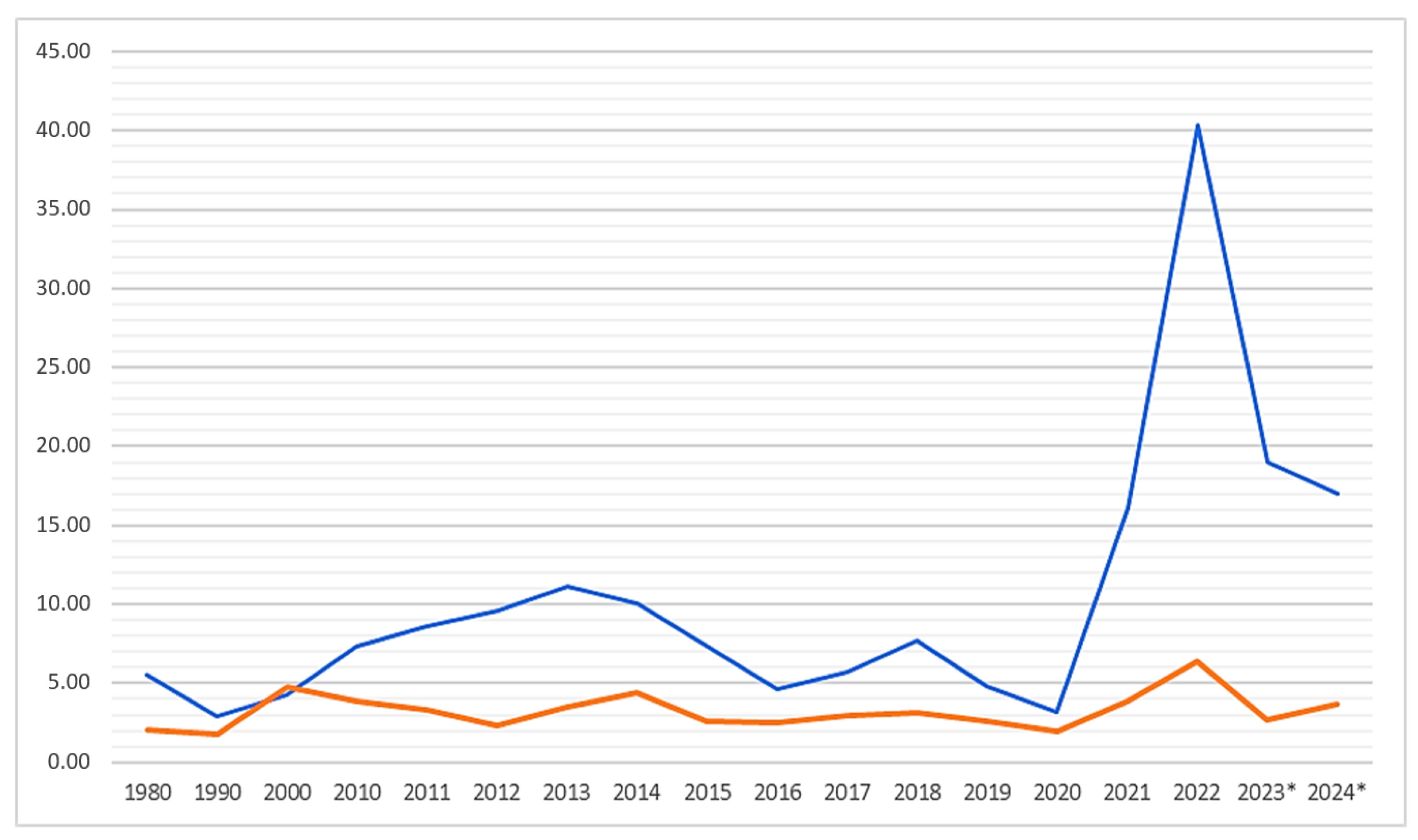
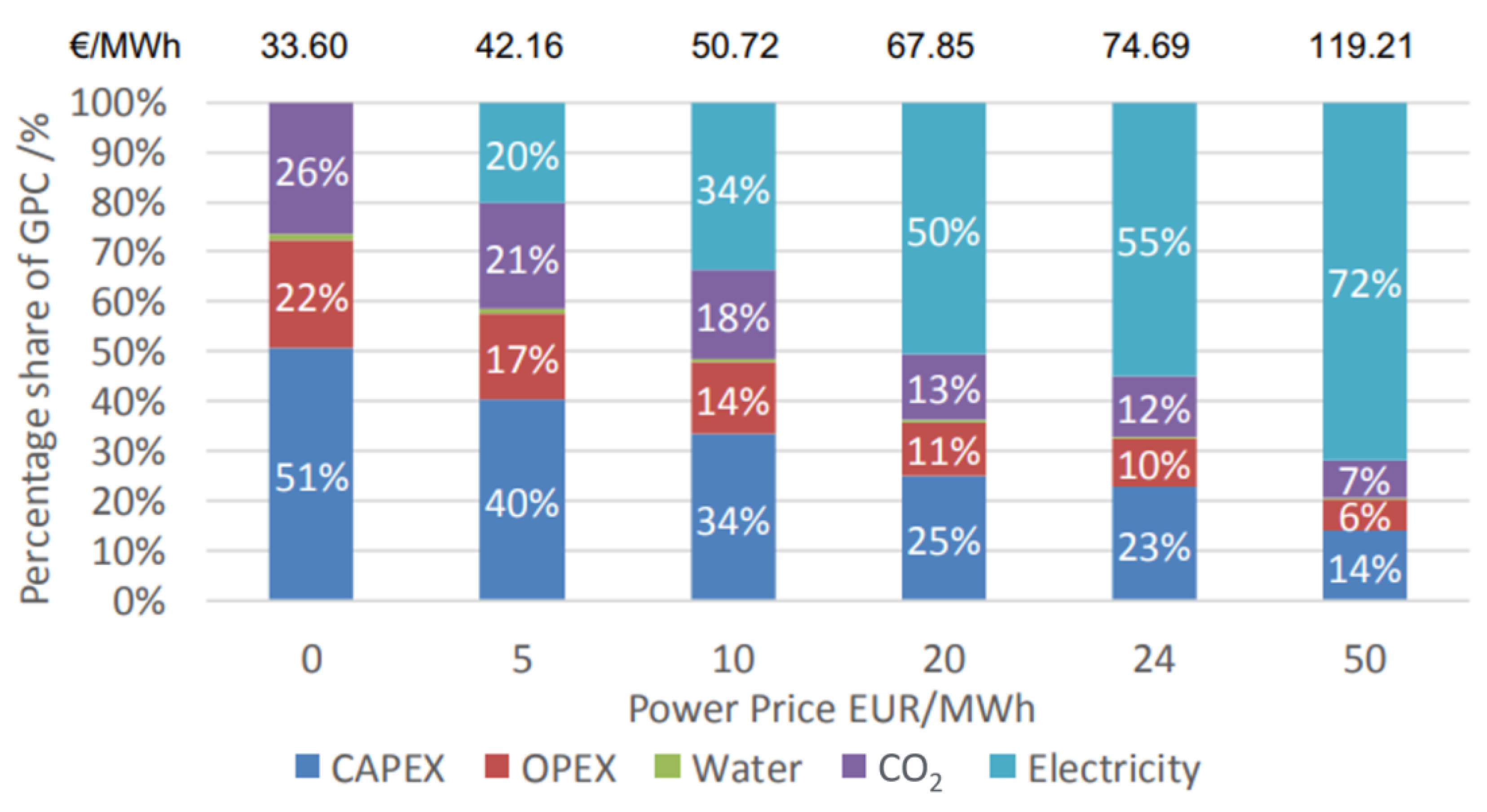

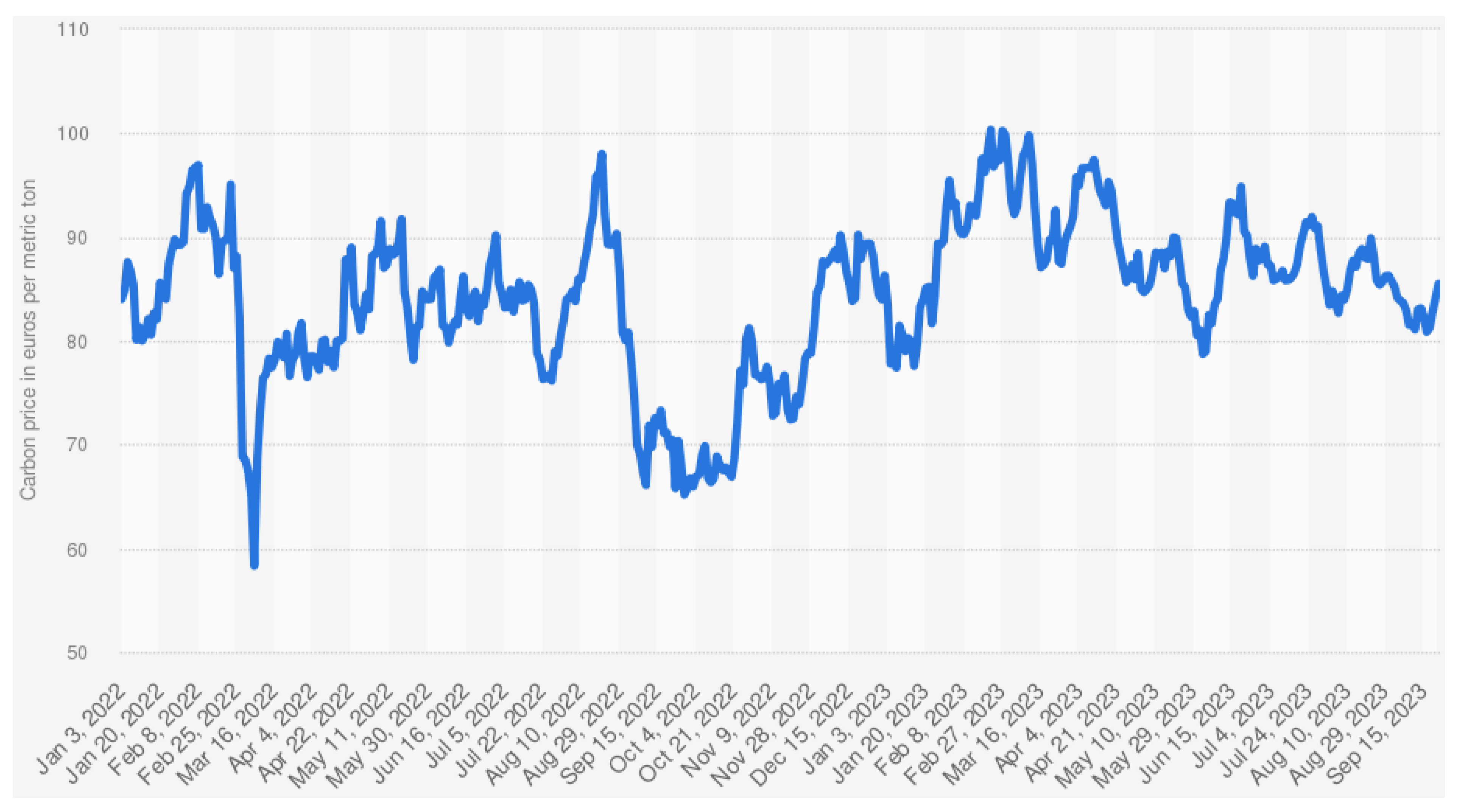
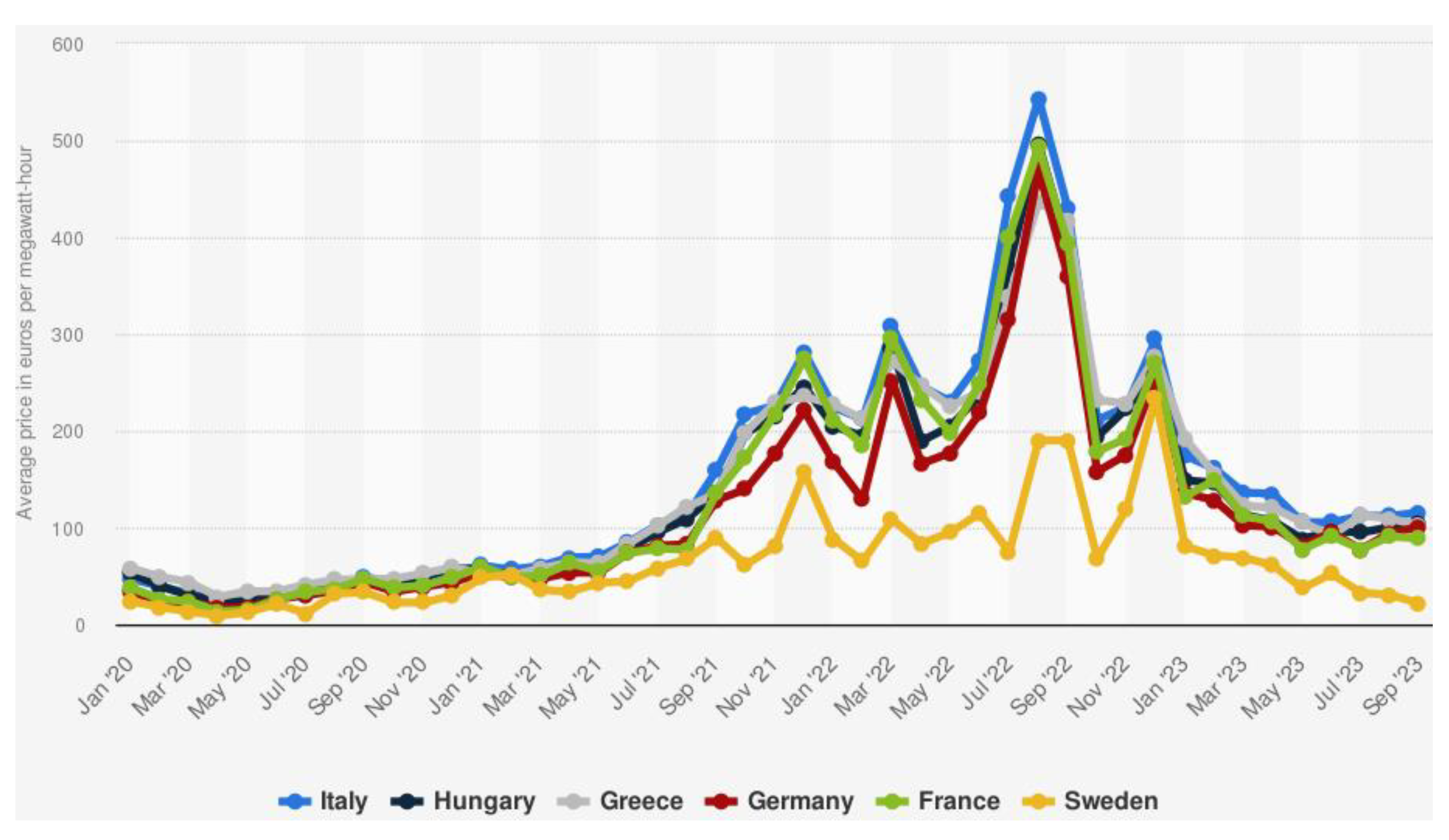
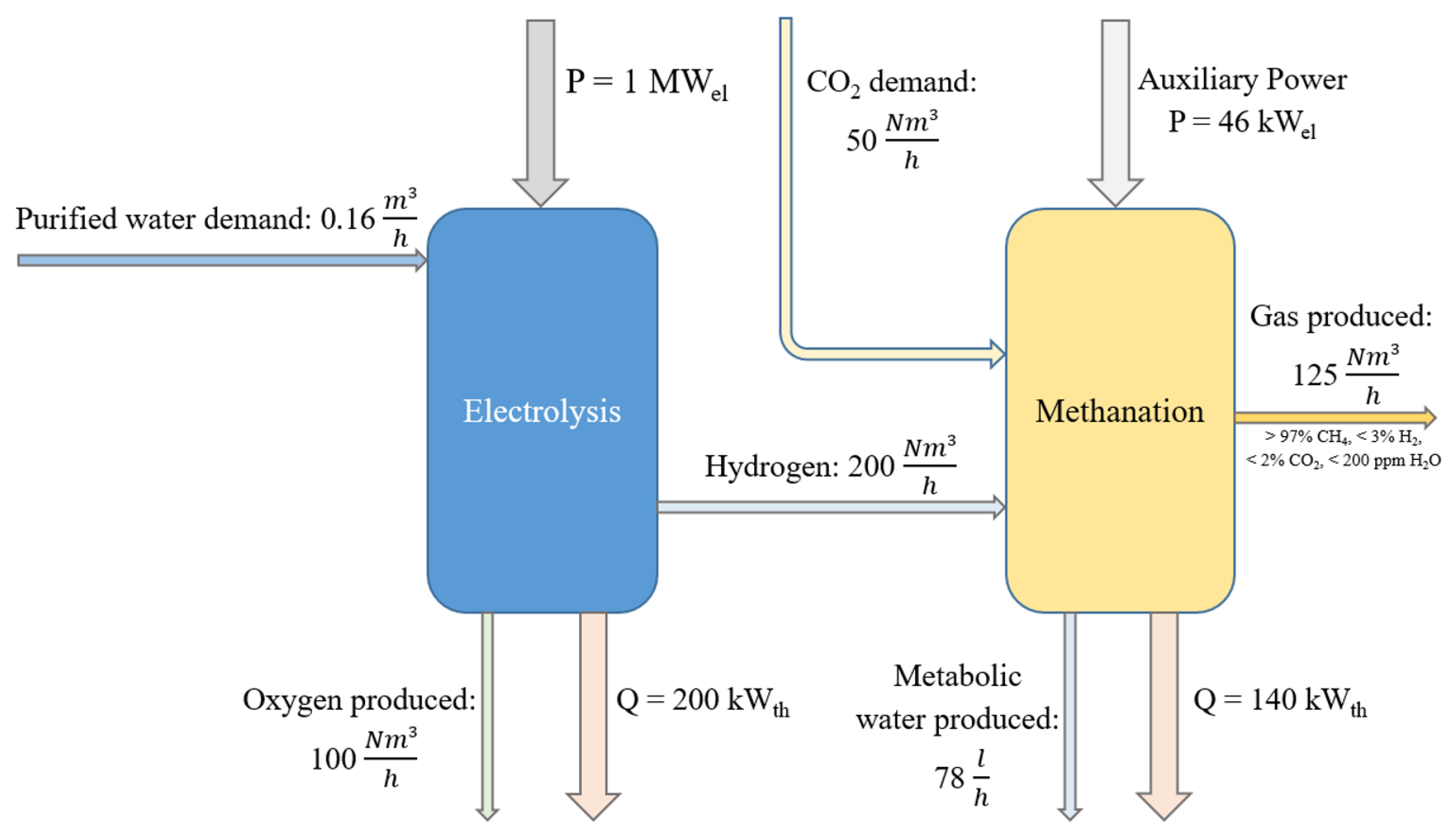
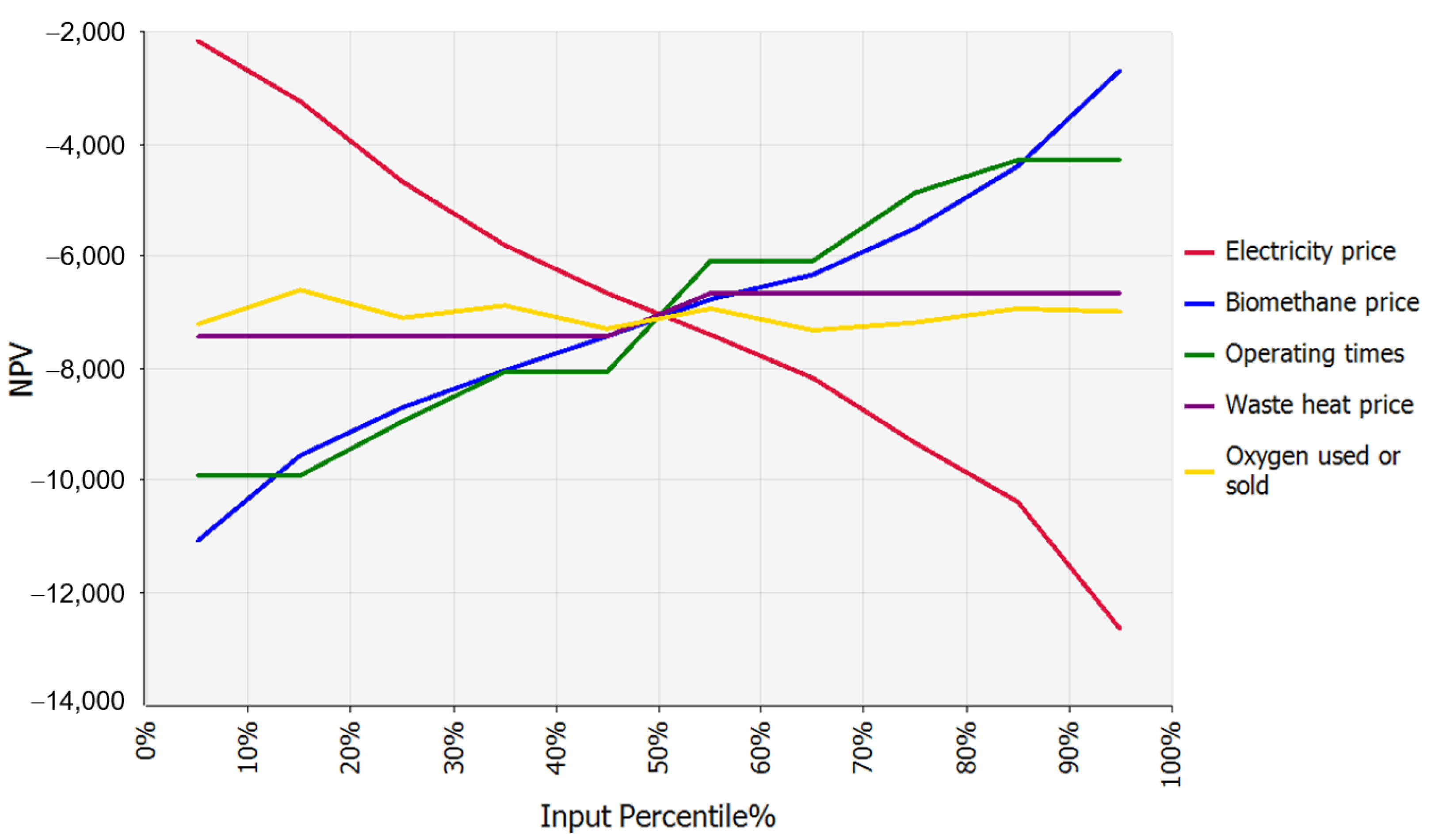
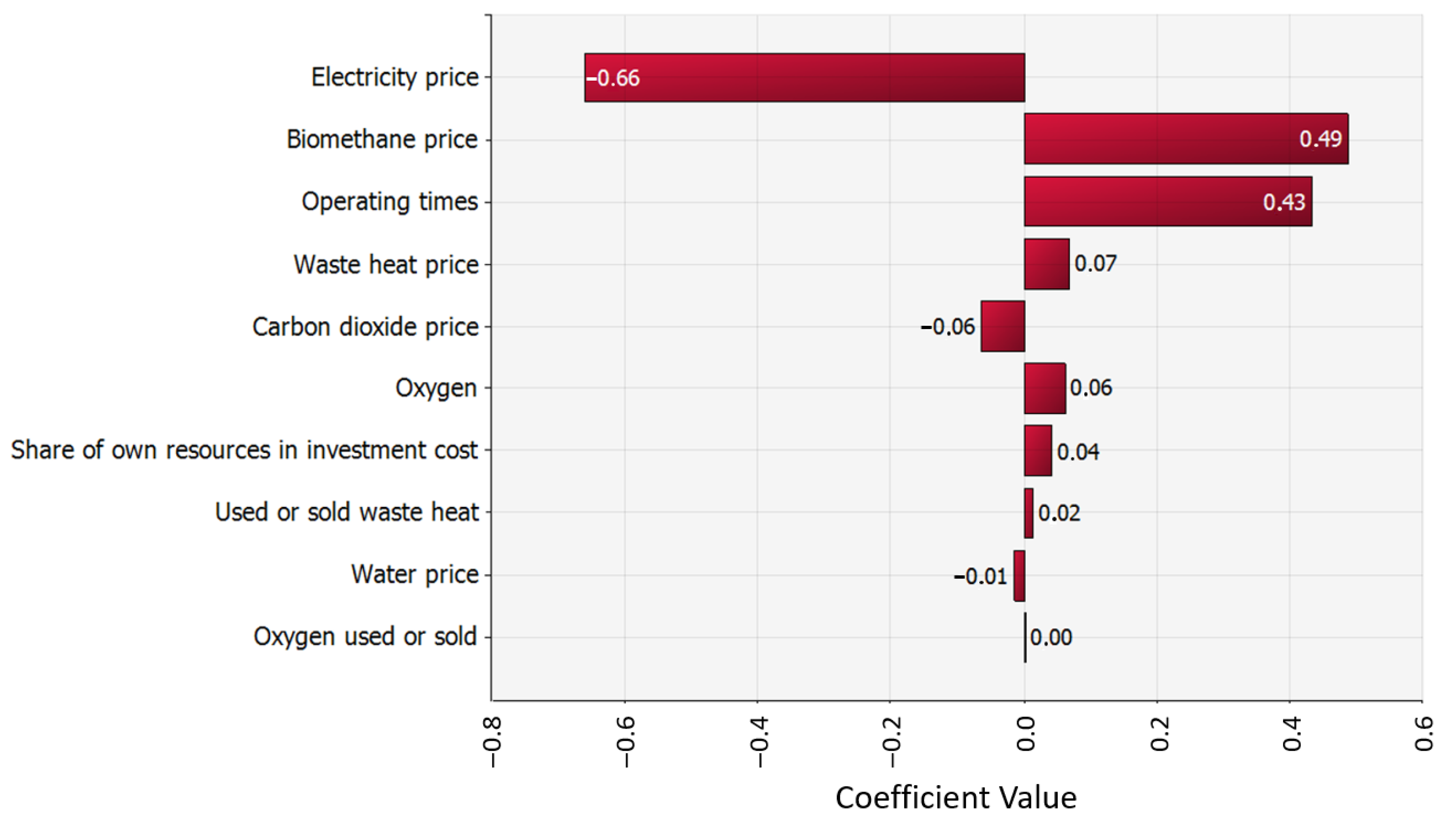
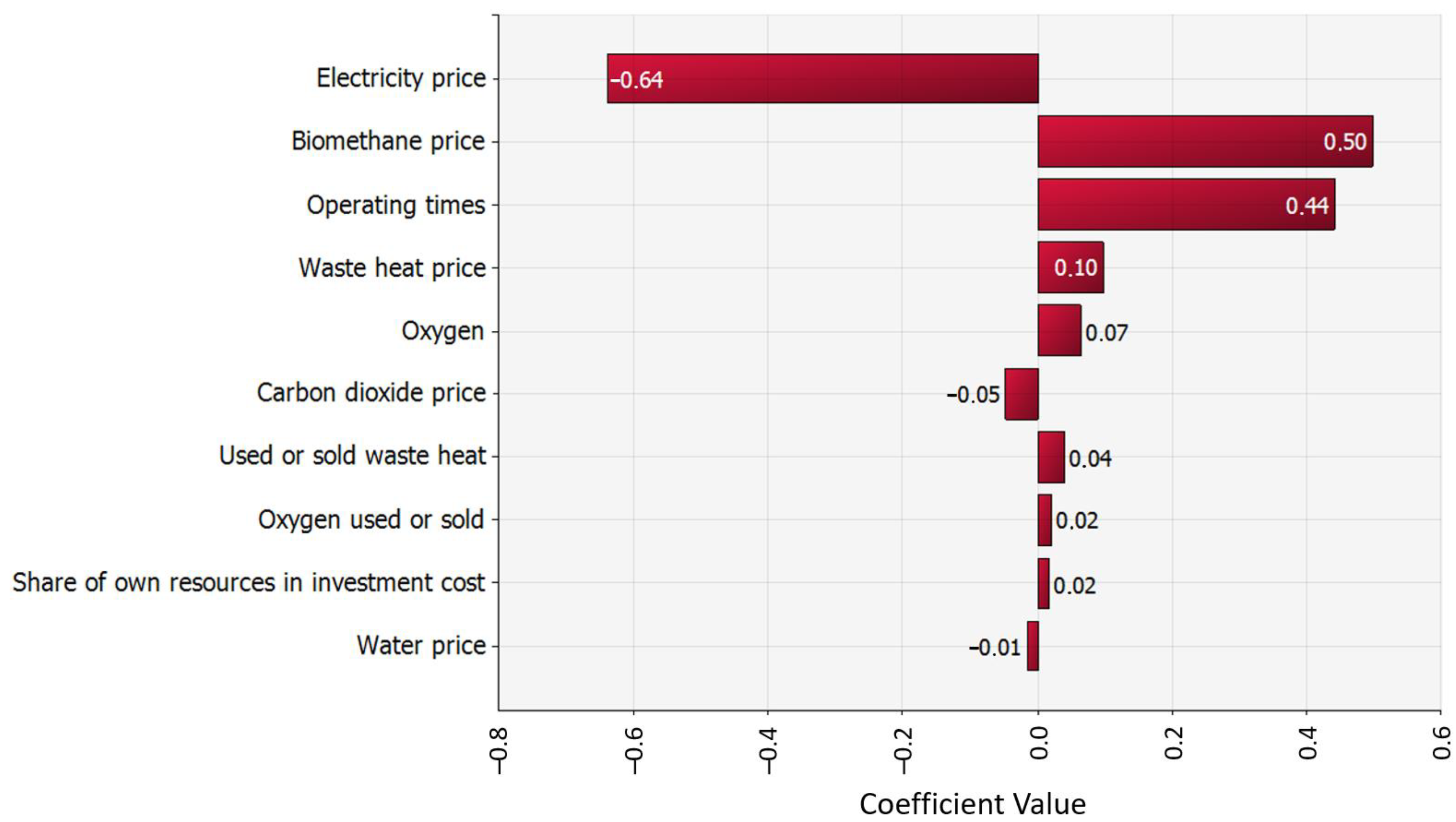
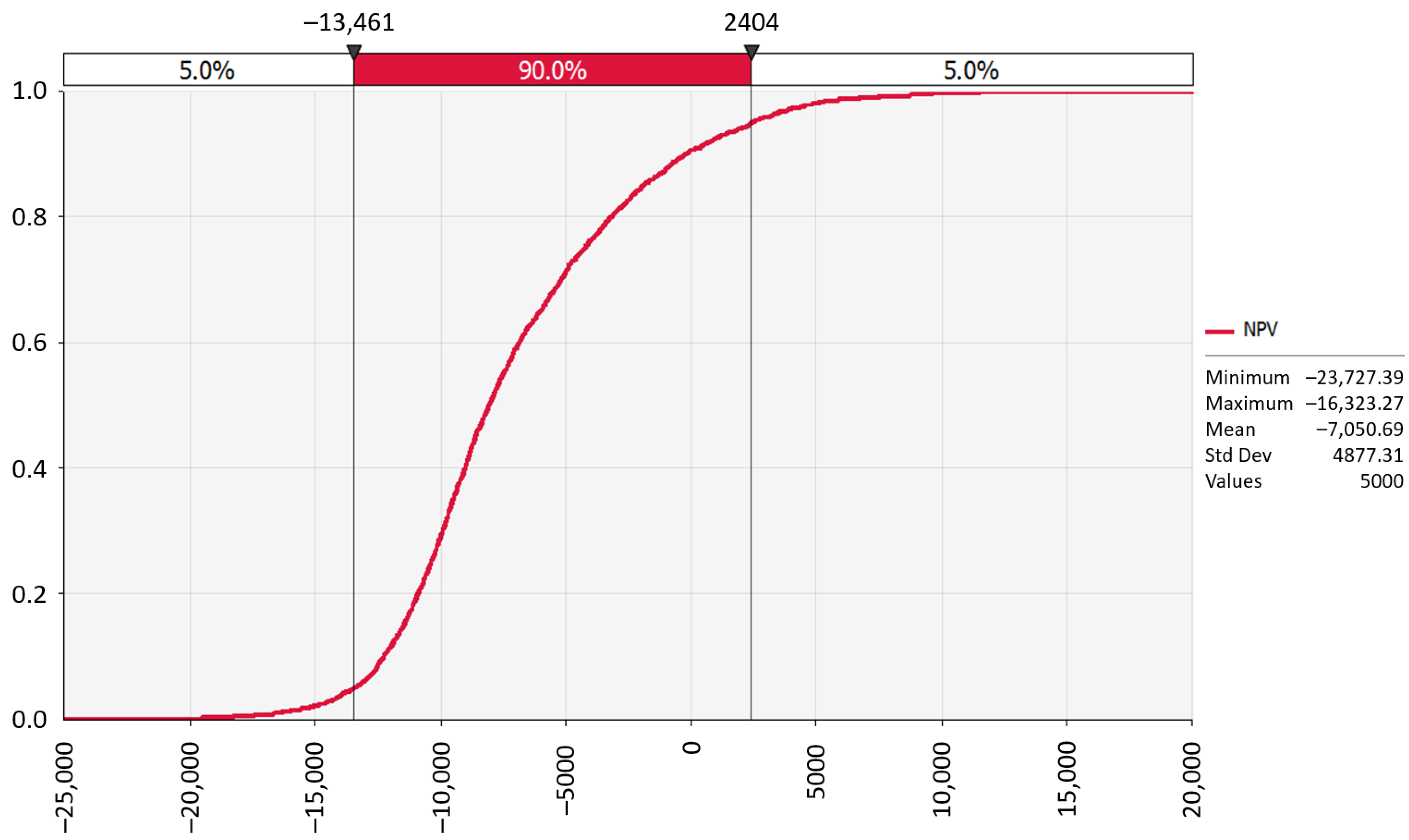
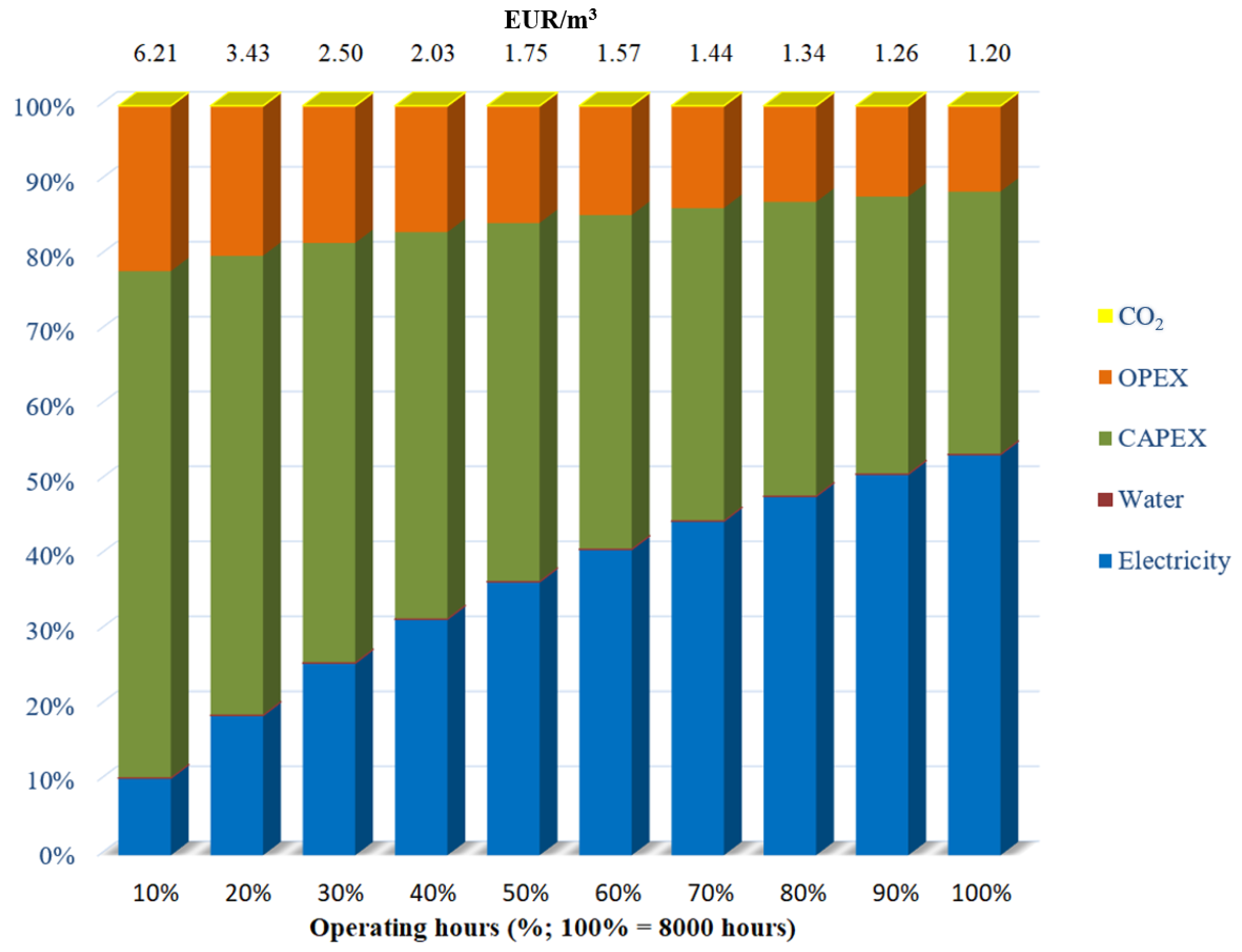
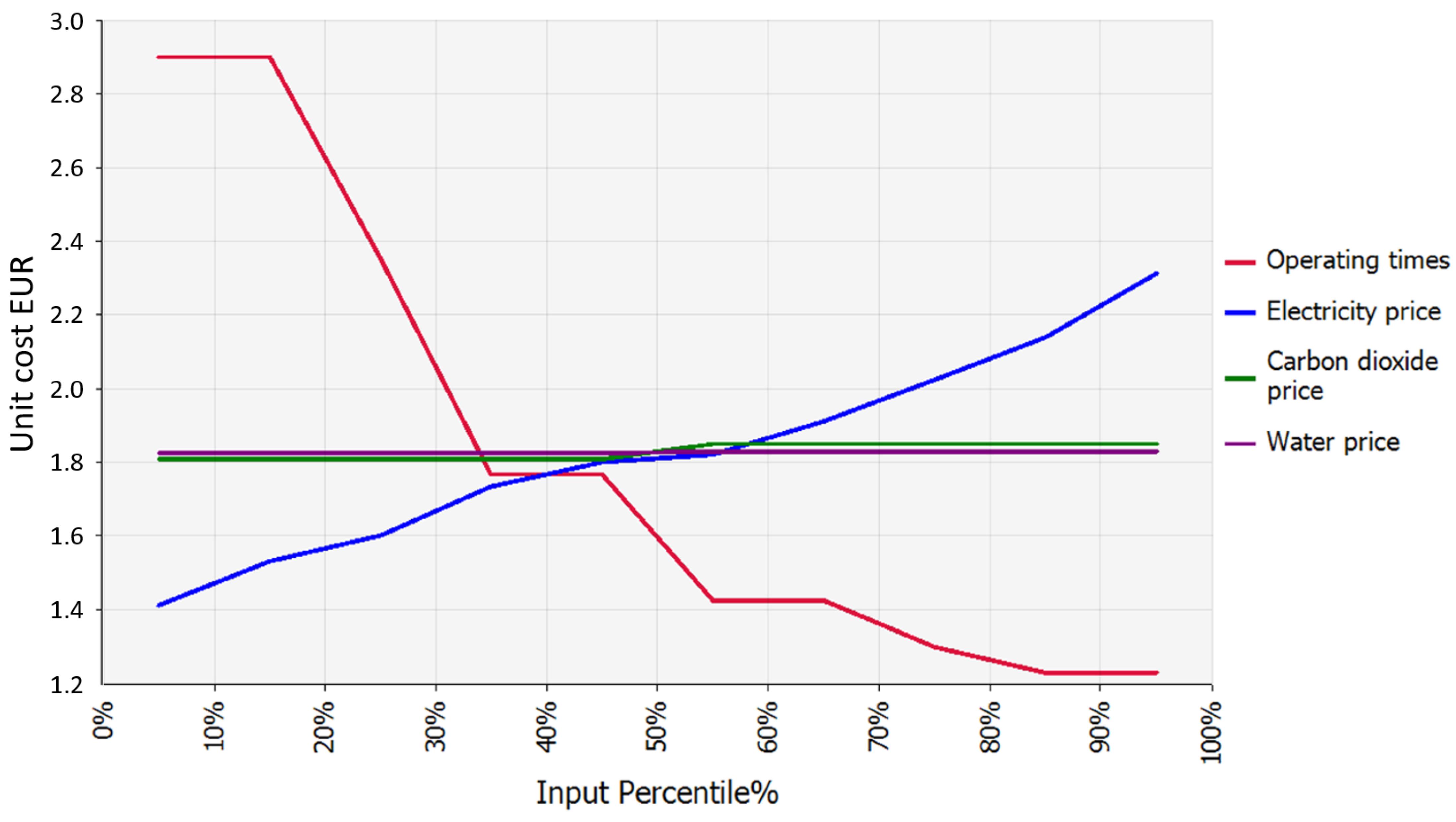
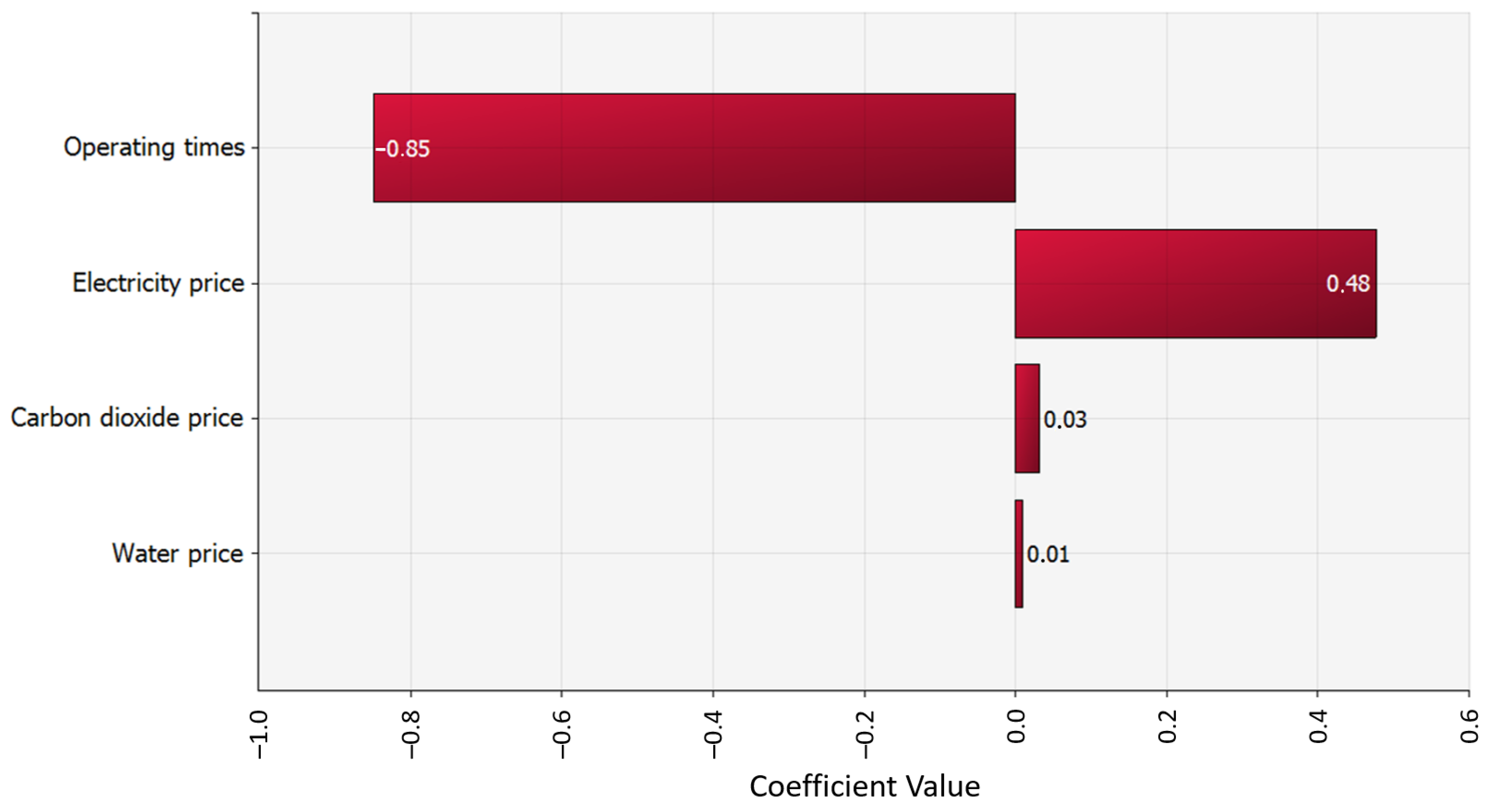

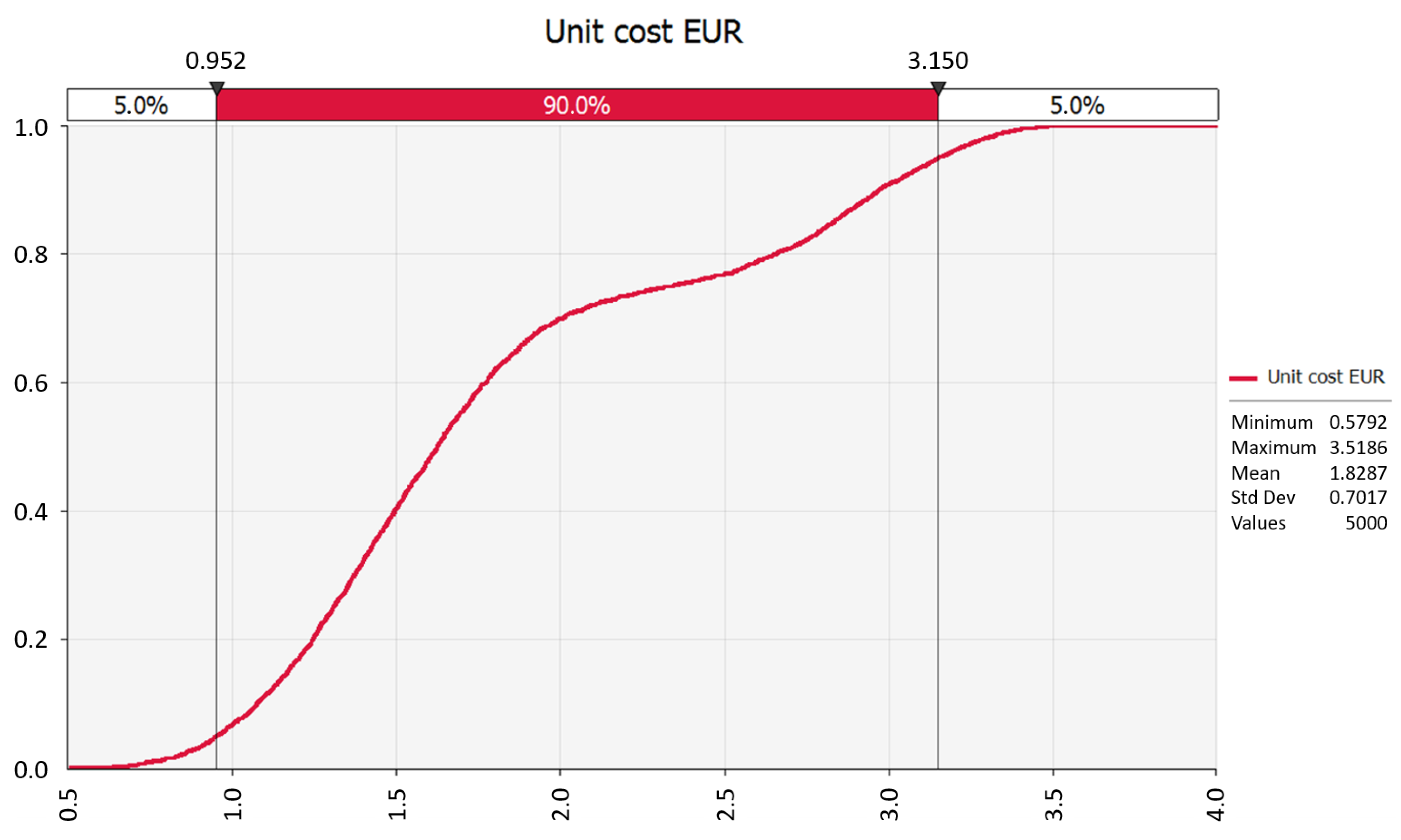
| Indicators | Intervals Used in the Simulation | Type of Distribution |
|---|---|---|
| Investment analysis | ||
| Share of own capital in investment cost (%) | 10–30–50–100 | Discrete uniform distribution |
| Electricity price (EUR/MWh) | 0–80–160 | Triangle distribution |
| Water price (EUR/m3) | 0–3 | Discrete uniform distribution |
| Carbon dioxide price (EUR/t CO2) | 0–50 | Discrete uniform distribution |
| Biomethane price (EUR/MWh) | 50–100–150 | Triangle distribution |
| Waste heat price (EUR/MWh) | 0–55 | Discrete uniform distribution |
| Oxygen (EUR/Nm3) | 0–0.15 | Discrete uniform distribution |
| Operating hours (hours per year) | 2000–4000–6000–8000 | Discrete uniform distribution |
| Used or sold waste heat (%) | 0–50–100 | Triangle distribution |
| Oxygen used or sold (%) | 0–50–100 | Triangle distribution |
| Unit cost of biomethane | ||
| Operating hours (hours per year) | 2000–4000–6000–8000 | Discrete uniform distribution |
| Carbon dioxide price (EUR/t CO2) | 0–50 | Discrete uniform distribution |
| Electricity price (EUR/MWh) | 0–80–160 | Triangle distribution |
| Water price (EUR/m3) | 0–3 | Discrete uniform distribution |
| Category | Item | Thousand EUR | Measure | Source |
|---|---|---|---|---|
| Components, physical infrastructure | Electrolyzer system | 1.1 | /kWe | [50,51,54,65,68,80] |
| Methanation system (biological) | 0.6 | /kWe | ||
| Infrastructure, installation, storage for gas puffer (H2 and CO2) and injection | 1.1 | /kWe | ||
| Other | Project development, planning, expert services and quality management | 28% | on costs of total components | |
| Tender-specific R&D, software and maintenance tasks | 50% | |||
| Total investment cost (CAPEX) of the 1 MWel system (thousand EUR): | 4984.0 | |||
| Share of own capital in investment cost | 10%–30%–50%–100% | |||
| Category | Item | Value | Measure | Source |
|---|---|---|---|---|
| Operation and maintenance costs | Electrolysis system | 4.0% | % of CAPEX | [50,51,54,81] |
| Methanation system | 5.0% | |||
| Infrastructure, installation, storage for gas puffer (H2 and CO2) and injection | 3.5% | |||
| Input materials and unit prices | Electricity price | 0–40–80–120–160 | EUR/MWh | [82,83] |
| Water | 0–3 | EUR/m3 | [84] | |
| CO2 | 0–50 | EUR/t | [83] | |
| Outputs, revenues | Biomethane | 50–100–150 | EUR/MWh | [54,85,86] |
| Waste heat | 0–55 | EUR/MWh | [54,83,87] | |
| Oxygen | 0–0.15 | /Nm3 | ||
| Operation data | Operating hours | 2000–4000–6000–8000 | h | Changeable cells |
| Sold or injected biomethane | 100% | /total produced | ||
| Used or sold waste heat | 0%–50%–100% | /total produced | ||
| Used or sold oxygen | 0%–50%–100% | /total produced |
| PLANNING OF EXPENDITURES AND REVENUES (Unit of Measurement: Thousand EUR): | Years | |||||
|---|---|---|---|---|---|---|
| 0 (Year of Implementation) | 1 | 5 | 10 | 15 | ||
| 1. INVESTMENT COST (CAPEX) | −4984 | |||||
| 2. ANNUAL EXPENDITURES (OPEX) | ||||||
| Operation and maintenance costs | Electrolysis system | - | 112 | 112 | 112 | 112 |
| Methanation system | - | 140 | 140 | 140 | 140 | |
| Infrastructure, installation, storage for gas puffer (H2 and CO2) and injection | - | 98 | 98 | 98 | 98 | |
| Input materials and unit prices | Electricity price | - | 640 | 640 | 640 | 640 |
| Water | - | - | - | - | - | |
| CO2 | - | - | - | - | - | |
| ANNUAL EXPENDITURES (OPEX) IN TOTAL: | 990 | 990 | 990 | 990 | ||
| Annual increase in prices of inputs and services, multiplier | 1.000 | 1.030 | 1.159 | 1.344 | 1.558 | |
| OVERALL (CAPEX + OPEX) with price increases: | −4984 | 2010 | 2138 | 2320 | 2532 | |
| 3. ANNUAL REVENUES | ||||||
| Outputs, revenues | Biomethane | - | 1000 | 1000 | 1000 | 1000 |
| Waste heat | - | 75 | 75 | 75 | 75 | |
| Oxygen | - | 60 | 60 | 60 | 60 | |
| ANNUAL REVENUES IN TOTAL: | 1135 | 1135 | 1135 | 1135 | ||
| Annual increase in prices of outputs and revenues, multiplier | 1.000 | 1.030 | 1.159 | 1.344 | 1.558 | |
| OVERALL REVENUES with price increases: | 2304 | 2450 | 2660 | 2903 | ||
| CASH FLOW | −4984 | 294 | 313 | 339 | 370 | |
| Discount factor | 1.000 | 1.078 | 1.458 | 2.127 | 3.102 | |
| NET PRESENT VALUE (NPV): | −4984 | −4711 | −3771 | −2871 | −2198 | |
Disclaimer/Publisher’s Note: The statements, opinions and data contained in all publications are solely those of the individual author(s) and contributor(s) and not of MDPI and/or the editor(s). MDPI and/or the editor(s) disclaim responsibility for any injury to people or property resulting from any ideas, methods, instructions or products referred to in the content. |
© 2023 by the authors. Licensee MDPI, Basel, Switzerland. This article is an open access article distributed under the terms and conditions of the Creative Commons Attribution (CC BY) license (https://creativecommons.org/licenses/by/4.0/).
Share and Cite
Bai, A.; Balogh, P.; Nagy, A.; Csedő, Z.; Sinóros-Szabó, B.; Pintér, G.; Prajapati, S.K.; Singh, A.; Gabnai, Z. Economic Evaluation of a 1 MWel Capacity Power-to-Biomethane System. Energies 2023, 16, 8009. https://doi.org/10.3390/en16248009
Bai A, Balogh P, Nagy A, Csedő Z, Sinóros-Szabó B, Pintér G, Prajapati SK, Singh A, Gabnai Z. Economic Evaluation of a 1 MWel Capacity Power-to-Biomethane System. Energies. 2023; 16(24):8009. https://doi.org/10.3390/en16248009
Chicago/Turabian StyleBai, Attila, Péter Balogh, Adrián Nagy, Zoltán Csedő, Botond Sinóros-Szabó, Gábor Pintér, Sanjeev Kumar Prajapati, Amit Singh, and Zoltán Gabnai. 2023. "Economic Evaluation of a 1 MWel Capacity Power-to-Biomethane System" Energies 16, no. 24: 8009. https://doi.org/10.3390/en16248009
APA StyleBai, A., Balogh, P., Nagy, A., Csedő, Z., Sinóros-Szabó, B., Pintér, G., Prajapati, S. K., Singh, A., & Gabnai, Z. (2023). Economic Evaluation of a 1 MWel Capacity Power-to-Biomethane System. Energies, 16(24), 8009. https://doi.org/10.3390/en16248009












